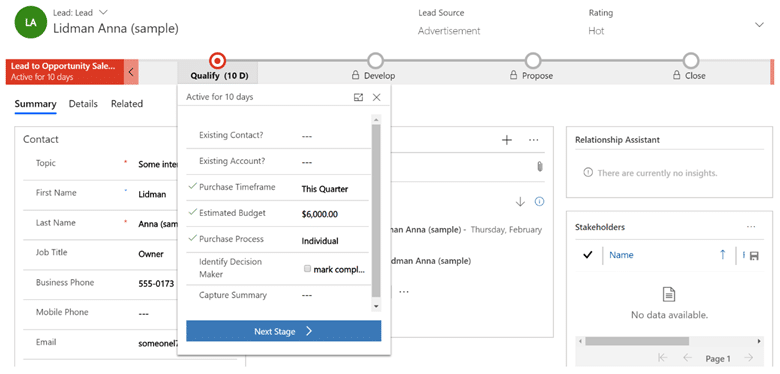Everything You Need to Know About Dynamics 365 Business Process Flows
Getting the Most Out of Your Business Processes With Dynamics 365 Business Process Flows
When running an organization of any significant size—from a small business to a large corporation—it’s a good idea to systematize repeated tasks to avoid errors, maximize efficiency, and maintain the uniformity of the data you collect.
With this in mind, your executive and management teams carefully craft business processes across departments—human resources, sales, marketing, customer service, finance, operations, and more.
With robust business processes in place, the problem isn’t the processes (although you’re likely to be constantly tweaking them), but rather the inconsistent application of the processes:
- Data not collected
- Budgets not set
- Approvals skipped
- Product promised when it’s not in stock
- Service cases closed prematurely
You can probably track down who left out a new customer’s shipping address or who marked Ticket #68395 resolved when it wasn’t—but that won’t eliminate the problem. Running more training sessions costs time and money, not to mention the loss in productivity while everyone’s in training.
Fortunately, there’s a tool in Microsoft Dynamics 365 that can walk users through any process within your system: Business process flows (BPFs). If you’re already using a Dynamics 365–based enterprise resource planning (ERP) or customer relationship management (CRM) system, you can start implementing business process flows right away; if you’re researching whether a Dynamics 365 ERP or CRM is a good fit for your company, this is a feature that will make your decision easier.
Stoneridge Software is a Microsoft Inner Circle Partner for Business Applications. We partner with companies of all sizes to implement and support Microsoft Dynamics 365 CRM and ERP solutions and frequently provide opportunities for training on how to get the most out of Dynamics 365. In this blog, we’ll bring you up to speed on the capabilities of Microsoft Dynamics 365 and explain how the business process flows can ensure user adoption and adherence to your established procedures.
What Is Microsoft Dynamics 365?
Microsoft Dynamics 365 is a collection of cloud-based business applications that can be implemented as ERP or CRM solutions for businesses of all sizes.
Microsoft Dynamics 365 Benefits
Key advantages of Dynamics 365 include:
- Integrated systems: With Dynamics 365, your data is shared natively and automatically across all your systems, from front-office financials to warehouses and factory floors to marketing, sales, and customer service.
- Controlled costs: The software-as-a-service (SaaS) licensing model ensures predictable per-user expenses for your solution.
- Savings: The cloud-based Dynamics 365 offerings run on any browser-equipped, internet-connected device—desktop, tablet, or smartphone. This eliminates the need for on-site server infrastructure and time-consuming software updates, saving money on information technology (IT) overhead and labor.
- Flexibility: Quickly add or eliminate applications and users as needed. This means your Dynamics 365 systems can easily grow alongside your business.
- Security and stability: In a Dynamics 365 ERP or CRM solution, your data are protected by Microsoft’s state-of-the-art security features and stored in multiple physical locations.
- Microsoft integration: Dynamics 365 was built for airtight integration with other Microsoft business applications, including Microsoft 365 productivity software like Outlook, Teams, and Excel and Microsoft Power Platform.
Microsoft Dynamics 365 Applications
The business programs available in the Dynamics 365 suite include:
- Dynamics 365 Business Central
- Dynamics 365 Customer Engagement
- Sales
- Customer Service
- Field Service
- Customer Insights
- Finance
No matter how good a software solution is, it can’t serve its purpose unless users adopt the system and use it consistently and correctly. Let’s take a look at how business process flows in Dynamics 365 make that happen.
What Is a Business Process Flow in Dynamics 365?
A Dynamics 365 business process flow is a step-by-step visual guide displayed in the screen header that leads users through an established business process. Although business process flows can be as simple as a few consecutive steps, they can also codify complex sequences with conditional branches that stretch across multiple business areas.
Simply put, they are a visual guide for you and your team to walk through a process pertinent to your business.
For example, suppose you want all customer representatives to follow the same process to ensure consistent service. You might create a business process flow for reps that leads them through account confirmation, data collection, and troubleshooting and either results in case resolution or triggers follow-up from a more skilled technician.
A business process flow for sales might include lead qualification, trigger an automated third-party credit check, and direct the sales agent to pursue an upsell. Or as referenced in the example below, it can give your team a visual task list that you must complete before submitting and closing the sales process.
The applications of business process flows are diverse, but they share common benefits:
- User adoption: Whether you have a new, long-established, or updated process, a business process workflow increases user adoption by walking users through the process.
- Reduced training: New employees can rapidly get up to speed if they’re not constantly trying to remember or look up the steps of a given process. Business process flows give them a pathway to follow.
- Quality data collection: Data flows freely among the applications included in your Dynamics 365 CRM or ERP, but uneven adherence to data entry standards degrades the quality of the insights you can gain from that data. Using business process flows, you can ensure that essential data aren’t left out, required approvals are obtained, and related processes are initiated promptly.
Creating a Dynamics 365 Business Process Flow
Business process flows are created in Power Automate or PowerApps using a no-code, drag-and-drop interface. The no-code setup process enables executives or managers who own a business process to oversee the creation of a BPF that codifies its stages and steps without involving a development team.
In September 2022, Microsoft reported, “We do not yet support creating business process flows from a template.” Regardless, the creation process is simple enough that this does not present a barrier to using the BPF tool.
Dynamics 365 Business Process Flow Features
Dynamics 365 uses business tables to handle data within your CRM or ERP. Dynamics 365 applications include many standard business entities, such as:
- Account: Used to manage customer accounts
- Campaign: Used to manage marketing campaigns
- Order: Used to manage sales
An entity correlates roughly to a database table; the attributes of a table correspond to table columns, and a table record corresponds to a table row. When you create a new business process flow in Dynamics 365, you’re creating a custom table that can be assigned its own attributes and metadata and collect business data as you use it.
Business process flow features include:
- Stages are the broad phases of your process. For example, a marketing campaign process might include four stages:
1. Plan
2. Budget
3. Produce
4. Publish - Steps are the discrete tasks that must be completed within each stage. These may include text boxes for data entry, check boxes, menus, and so forth. Data can be further manipulated with formulas or used to trigger other processes. For example, the Plan stage of the marketing BPF might include a menu to select the type of marketing campaign (e.g., social media or Google Ads). A text box could be used to collect a description of the campaign.
- The progress header at the top of the screen indicates what stages in a business process flow have been completed.
- Required steps prevent users from advancing to the next step or stage unless the required step has been completed. This is sometimes called “stage gating.” For example, the Plan stage of the marketing BPF might prevent users from advancing to the Budget stage without indicating the campaign type.
- Conditions let you create branches within a BPF. For example, the Budget stage might include a condition to seek approval for budgets in excess of $10,000. If the budget is $11,000, the BPF branches into an Approval stage; the user can proceed to the Produce stage only after the appropriate approval is obtained.
- Workflows added to a business process flow can be set to run automatically or on demand. For example, a workflow might notify a manager that they need to approve a marketing budget. An on-demand workflow requires the user to activate it; an automatic workflow is initiated simply by the requisite budget threshold being met. An account creation business process flow could use an automated workflow to send a welcome email as soon as a new account is created.
- You can use roles to limit access to business process flows. Users will only see and be able to access process flows that align with their role within the system.
- Performance tracking lets you see how long users spend completing a given business process flow and the rates at which the BPF is either completed or abandoned.
Limitations on Business Process Flows
There are a few limitations on business process flow parameters, as follows:
- A business process flow can have a maximum of 30 stages.
- Each stage is limited to 30 steps.
- A business process flow that uses more than one table can include a maximum of five tables.
- Tables are limited to 10 associated business processes.
Partner With Stoneridge to Streamline Your Business Processes
Stoneridge Software is a business built on successfully implementing CRM and ERP solutions in Microsoft Dynamics. We recognize that a CRM or ERP is a major investment and view every engagement as a partnership. We take the time to get to know your business needs and goals, involve you in an iterative development process, help you engage and train your employees, and provide ongoing support and learning opportunities.
Microsoft Dynamics 365 offers a wealth of opportunities to refine your business processes, increase profitability and competitiveness, and grow—far beyond the significant benefits offered by Dynamics 365 business process flows.
To learn more about partnering with Stoneridge, contact us today.
Under the terms of this license, you are authorized to share and redistribute the content across various mediums, subject to adherence to the specified conditions: you must provide proper attribution to Stoneridge as the original creator in a manner that does not imply their endorsement of your use, the material is to be utilized solely for non-commercial purposes, and alterations, modifications, or derivative works based on the original material are strictly prohibited.
Responsibility rests with the licensee to ensure that their use of the material does not violate any other rights.







